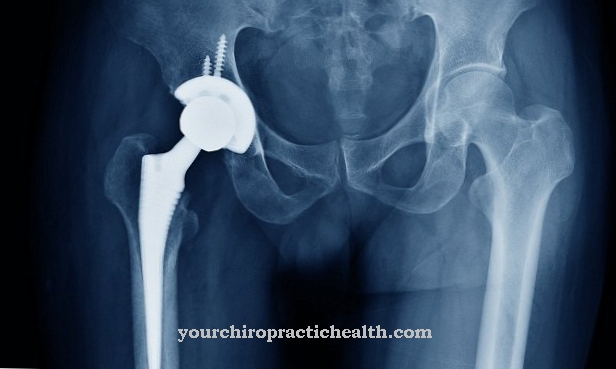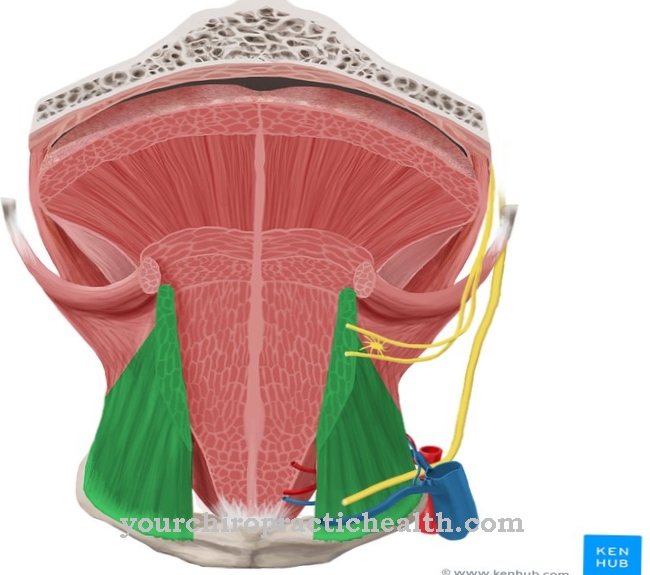The Hyoid bone is a very small and therefore mostly underestimated bone that is located below the tongue on the floor of the mouth. The medical names are Os hyoideum respectively Hyoid.
What is the hyoid bone?
The hyoid bone between the larynx and the lower jaw is only two to three centimeters long and curved in a U-shape. As a rule, it is viewed as part of the skull skeleton. However, this point is controversial, since the hyoid bone is already in the throat area at the transition to the neck.
The hyoid bone is an unpaired bone that can be felt through the skin as well as with the usual imaging examination methods such as X-rays, ultrasound or computer tomography. The integration of the hyoid bone into its environment is optimal, especially since it is only fixed with various muscles and ligaments in the area of the base of the skull.There is no connection to other bones and thus to the skeleton. Skeletal models are therefore often incomplete with regard to the hyoid bone.
The complex interaction of the hyoid bone, the adjacent muscles and the surrounding body parts is the basis for error-free swallowing, breathing and speaking. The hyoid bone even has an influence on coughing and various movements.
Anatomy & structure
The hyoid bone is composed of a middle piece, the corpus ossis hyoidei, and four so-called hyoid horns. Two of the horns, medical cornu majus, point backwards and end with a small thickening.
They form in the embryonic phase together with the middle section from the cartilage of the third pharyngeal arch and are connected to the larynx. The two front horns, Cornu minus, are slightly smaller and come from the second pharyngeal arch. They are connected to the temporal bone via the stylus process - an ossified connection that is only found in humans and other primates.
The muscles surrounding the hyoid bone are divided into two groups, each containing external and deeper muscles. While the suprahyal muscles (musculus geniohyoideus, musculus mylohyoideus, musculus digastricus, musculus stylohyoidus) are able to pull the hyoid bone upwards, the infrahyal muscles (musculus sternohyoideus, musculus omohyoideus, musculus omohyoideus downward of the zyloidal muscle) allow pulling down of the hyoid bone. The muscles lead towards the tongue, throat and jaw. There are even connections to the chest and shoulder blades.
Function & tasks
Without the movements of the hyoid bone and the contractions of the muscles connected to it, the functions of speaking, breathing and swallowing cannot be carried out properly. Targeted movements of the tongue, for example, are only possible through the hyoid bone. This is stabilized by the small curved bone and only then allows the formulation of words.
The hyoid bone is supported by the larynx, which is connected to it by a flexible membrane through which the upper laryngeal artery also runs. In addition to the larynx, the windpipe is loosely attached to the hyoid bone. It can be closed or opened as required. During the swallowing process, the muscles pull the hyoid bone including the larynx upwards and press the lid of the larynx against the inside of the neck and close the entrance to the larynx.
Other muscle groups then pull the hyoid bone down. The food is pushed into the esophagus and breathing is released again through the windpipe. It is therefore not possible to swallow and breathe at the same time. However, if spoken in parallel, there is a risk that small pieces of food touch the larynx and windpipe and cause a coughing sensation.
But the hyoid muscles are not only important when swallowing. Among other things, they serve to open the jaw and the chewing movement through the connection to the floor of the mouth. In addition, as part of the neck muscles, they participate in the coordination of movements in the shoulders and neck area - a relationship that is often neglected.
You can find your medication here
➔ Medicines against tartar and tooth discolorationDiseases
Diseases of the hyoid bone itself are extremely rare. Inflammations or tumors can only be observed sporadically. Occasionally, carcinomas of the thyroid gland run through the hyoid bone to the tongue. Cysts, on the other hand, usually only form in the vicinity and do not affect this bone.
The hyoid bone can also break through the action of force. For this, however, a great deal of force is required, which can be achieved when strangling a person or strangling. Since such pressure is usually exerted involuntarily, the fracture of a hyoid bone is mainly an issue in forensic medicine. The force required for the break inevitably damages other parts of the neck area, and so a hyoid bone fracture is almost always diagnosed in the dead.
In contrast, there are complaints such as breathing problems or poor posture of the body. They occur frequently, but in many cases are not immediately associated with the hyoid bone and adjacent muscles. An example of this is the back of the lower jaw, in which the hyoid bone is unusually loosely anchored and lies too far back. The result is a narrowing of the windpipe, which causes breathing problems. Overstretching the head makes breathing easier for those affected, but it can also lead to tension, pain, migraines or bad posture.
Tension in the hyoid muscles can also have far-reaching consequences. If their activity is restricted due to immobility, tense movements, a stiff neck or discomfort when swallowing occur.






.jpg)






.jpg)

.jpg)
.jpg)











.jpg)